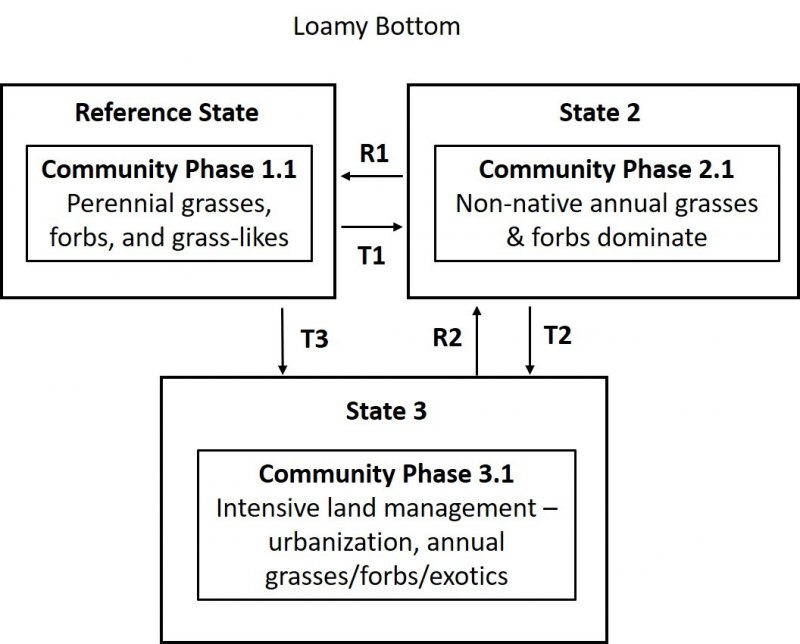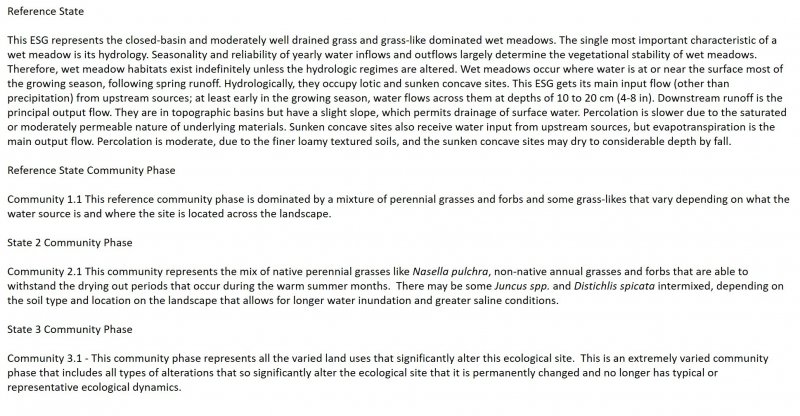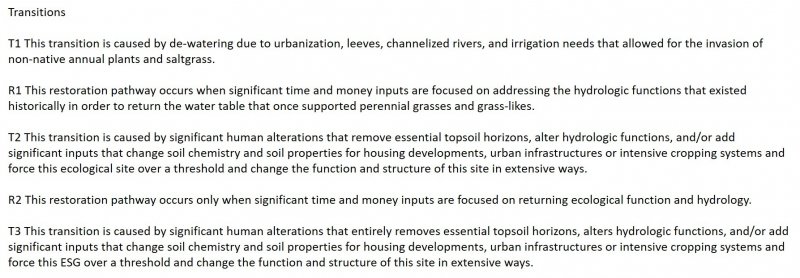Ecological site group R015XY003CAESG
Loamy Bottom
Last updated: 09/07/2023
Accessed: 12/22/2025
Ecological site group description
Key Characteristics
- located on basin floors
- loamy texture
Provisional. A provisional ecological site description has undergone quality control and quality assurance review. It contains a working state and transition model and enough information to identify the ecological site.
Physiography
This ESG is typically found on alluvial flats, basin floors, valley floors, floodplains, and stream terraces. Slopes typically range from 0 to 9% and elevations vary from sea level to 3000 ft.
Climate
The average annual precipitation in this area is typically 11 to 39 inches (280 to 1000 millimeters) . Some areas can get as low as 6 inches (150 millimeters), while the areas at higher elevations can reach up to 88 inches (2235 millimeters) on average. Snowfall is common in the northern half of the part north of San Francisco and rare elsewhere. Precipitation is evenly distributed throughout fall, winter, and spring but is very low in summer. Coastal areas receive some moisture from fog in summer. Most of the rainfall occurs as low- or moderate-intensity, Pacific frontal storms during the period October to May. The average annual temperature is 52 to 65 degrees F (11 to 18 degrees C), decreasing from south to north. The freeze-free period averages 275 days and ranges from 180 to 365 days, decreasing in length with elevation and from south to north.
Soil features
Soils in this ESG are extremely varied from fine-loamy to sandy loams, poorly drained to well drained, and a water table near the surface for part or more of the year. These soils are very fertile and moist soils for agriculture and thus extensive acres have been converted to croplands and vineyards.
The soils that represent this ESG include:
Alviso, a fine, mixed, superactive, nonacid, isomesic Typic Fluvaquents
Botello, a fine-loamy, mixed, superactive, thermic Pachic Argixerolls
Elder, a coarse-loamy, mixed, superactive, thermic Cumulic Haploxerolls
Vegetation dynamics
This ESG covers the areas of the valleys in MLRA 15 that were at one time part of a vast complex of marshes, tidal flats, estuaries, wetlands and wet meadows. The urbanized landscape in the valleys within this MLRA that exists today makes it difficult to imagine the natural landscape prior to human development.
These loamy bottoms were likely the loamy-textured depressions and deposition areas and isolated oxbows that were created from the network of freshwater and salt marshes, rivers and streams that ran through these valleys as their seasonal and tidally influenced flood waters stretched across the floodplains and terraces in spring and deposited sediment during summer as they receded. Once the area began to be settled, many of these water-dominated ecosystems were drained, leveed, cleared for crops and other agriculture, and urbanized.
As this landscape was de-watered and houses and agriculture took over, the water table for many of these habitats was lowered, creating soils that would no longer offer the available soil moisture for many of the plants that had evolved with the hydrologic function of the natural system that no longer existed. These loamy basins may have remained wetter than many of the surrounding soils, due to their prolonged available water capacity and their depressional location on the landscape. The variable range in soil textures will dictate the species composition and production, with the finer soils holding more water that results in more native perennials and forbs and higher annual production overall. The coarser textures will dry out more rapidly through both drainage and evapotranspiration in the summer months making them less hospitable for many of the native perennial grasses and more dominated by annual grasses and forbs. Annual production will still be higher than the other ESGs in bottoms, due to the loamy textures which provide decent available water and slightly slower but still well drained soil conditions.
Historically, this site may have looked similar to the California Wildlife Habitat Relationship (CWHR) wet meadow classification, however with the introduction of non-native annual grasses and the impacts from fragmentation, continued de-watering, and human alterations such as homes and roads, this site now reflects a lower producing, dry, annual grassland.
Currently, where this site is not under cultivation or urban development, it is dominated by non-native annual grasses. These include wild oats, soft chess, ripgut brome, red brome, wild barley, and foxtail fescue. Common forbs include broadleaf filaree, redstem filaree, turkey mullein, true clovers, bur clover, popcorn flower, and many others. Perennial grasses, found in moist, lightly grazed, or relic prairie areas, include purple needlegrass and blue wildrye and areas of intermittent ponding will be have sedges and rushes. Species composition is also related to water availability with greater amounts of relic perennial grasses in areas of greater precipitation or soil moisture.
Information from:
John G. Kie
California Wildlife Habitat Relationships System
California Department of Fish and Game
California Interagency Wildlife Task Group
Major Land Resource Area
MLRA 015X
Central California Coast Range
Stage
Provisional
Contributors
Kendra Moseley
Darren Pinnegar
Click on box and path labels to scroll to the respective text.


